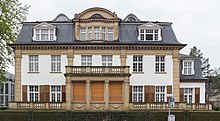Kurt-Schumacher-Strasse 10 (Bonn)
The building at Kurt-Schumacher-Straße 10 is a villa in the Gronau district of Bonn , which was built in 1922/23. It is located in the center of the federal quarter opposite the Schürmann building . The villa stands including their park as a monument under monument protection .
history
The villa was built for Henriqueta Lion, from Petrópolis originating wife of a client occurring Brazilian consul , as several buildings previously at the former Drachenfelsstraße in the "villa colony Gronau" according to a draft of the Bonn architects and government architect Julius Rolffs . The execution was in the hands of Rolffs' co-worker Ernst Sagebiel , who had been hired specifically for this project. In response to the building application from the end of January 1922, the building permit was granted in spring , and the villa, which was already fully furnished at the time of handover, was completed by the summer of 1923. Originally, apart from a garden pavilion, it also included several garages, a chauffeur's house , a dog kennel and a poultry house .
After Bonn had become the seat of government of the Federal Republic of Germany in 1949, the villa was located in the middle of the new parliament and government district . It was the country North Rhine-Westphalia rented and initially the SPD -Abgeordneten Carlo Schmid then provisionally including Secretariat, part of the country representative of Bavaria provided. From September 1949 to May 1950, the property was the seat of the newly founded Press and Information Office of the Federal Government , the chief of duty was based with his offices in the basement. At the beginning of February 1951, the Austrian liaison office in the Federal Republic of Germany, which had the character of a diplomatic mission, moved into the property. The five-room ground floor housed the office and the representative rooms of the liaison office, half of the first floor with three rooms housed the office manager's residence and the second floor housed the apartment of the press officer ( Alfred Missong ). The remaining rooms of the house were still occupied by three tenants, so that the accommodation of the connection point was felt to be clearly too cramped and inadequate. Therefore, the office moved out of the building at the beginning of 1954, and so did the head of the office by the end of the year (→ Embassy of the Republic of Austria (Bonn) ). By 1961 at the latest, the Republic of Egypt established the residence of its embassy , the residence of the ambassador, in the villa . In 1999 the embassy moved in the course of relocating the seat of government to Berlin (→ Egyptian embassy in Berlin ). The villa was the closest location to the seat of Parliament for a diplomatic mission in Bonn.
At the end of 2001, the Bonn entrepreneur Marc Asbeck acquired the property with its approximately 4000 m² property from Egypt for four million Deutschmarks . He then had it extensively renovated with the aim of leasing it as an office building under the direction of the Cologne architect Heribert Wiesemann at a cost of three million D-Marks. Belonging to the villa, located in the park at the Heinrich-Brüning-Straße and finally dilapidated shed (Heinrich-Brüning-Straße 15) was demolished, built in their place using the ground floor, a new office building. Today the villa serves as the headquarters of the Max Planck Institute for research on common goods .
The villa was entered in the city of Bonn's list of monuments at the beginning of 2002.
architecture
Stylistically , the villa can be assigned to the Neo-Baroque . It is a two-storey plastered building with a slate mansard roof , the facade of which has a sandstone structure. The original floor area of the house was around 300 m². The representative interiors were furnished with very high quality types of wood , stucco , marble and mosaic panels.
literature
- Hilda Ortiz Lunscken (ed.); Hilda Ortiz Lunscken, Ingeborg Fischer-Dieskau (Photos: Martin Krockauer): Pour Memoire. To Remind. As a reminder - ambassadorial residences on the Rhine. Ortiz-Lunscken Publishers, Bonn 1999, ISBN 3-9806801-0-X , pp. 88-91.
Web links
- Entry on the way of democracy
- Entry for Villa, Kurt-Schumacher-Straße 10 in the database " KuLaDig " of the Landschaftsverband Rheinland (with a short description of the LVR Office for Monument Preservation in the Rhineland by Angelika Schyma and Elke Janßen-Schnabel, 2005)
Individual evidence
- ↑ a b List of monuments of the city of Bonn (as of March 15, 2019), p. 36, number A 3757
- ↑ Bonner buys former Egyptian embassy , General-Anzeiger , January 6, 2002.
- ^ A b Elke Dittrich: Ernst Sagebiel: Leben und Werk , Lukas Verlag, 2005, ISBN 3-936-87239-2 , p. 35.
- ^ City of Bonn, City Archives (ed.); Helmut Vogt : "The Minister lives in a company car on platform 4": The beginnings of the federal government in Bonn 1949/50 , Bonn 1999, ISBN 3-922832-21-0 , pp. 57, 168.
- ^ Günther Diehl : Between politics and the press. Bonn memories 1949–1969 . Societäts-Verlag, Frankfurt 1994, ISBN 3-7973-0575-3 , p. IV.
- ^ Rudolf Agstner : 130 years of the Austrian Embassy Berlin: from Moltkestrasse to Stauffenbergstrasse , Philo, 2003, p. 85; Rudolf Agstner: Representation - Embassy - Branch Office: an obituary for Austria's diplomatic mission in Bonn from 1950 to 2006 . In: Bonner Geschichtsblätter. Yearbook of the Bonner Heimat- und Geschichtsverein , Volume 55/56, 2006, ISSN 0068-0052 , pp. 293–326 (here: pp. 301, 309).
- ↑ Chinese granite for the Rheinischer Merkur , General-Anzeiger, September 13, 2004.
Coordinates: 50 ° 43 '1.3 " N , 7 ° 7' 35.1" E

